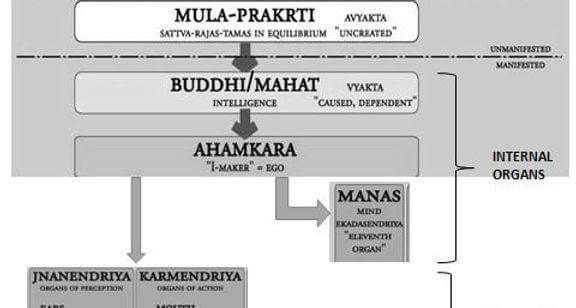Author: Randeep Singh / go to all Samkhya Karikas

Samkhya Karika 29 text:
Svaalakshanyam vrittih trayasya saishaa bhavatya saamaanyaa |
Saamaanya karana vrittih praanaadhyaa vaayavah pancha ||
Svaalakshanyam – self nature, essential characteristics
Vrittih – modifications, functions
Trayasya – of the three
Sa – with, the same
Ishaa – this
Bhavaty – so happens, is
Asaamaanyaa – unique, uncommon
Saamaanya – common
Karana Vrittih – functions and modifications of vrittihs
Praanaadhyaa – prana and the others
Vaayavah -airs
Pancha – the five
Samkhya Karika 29 begins the explanation of the functions of the three main internal faculties: buddhi, ahamkara, manas. These three entities are the first three subtle evolutes, in the same sequence, of Mula Prakriti. All the three are very subtle in nature owing to their nearness to the parent entities, Purusha and the Mula Prakriti.
These three subtle faculties are significant as the development and functioning of an individual’s personality depends on the quality of their nature in a particular individual.
Three Internal Faculties Fueled by Prana create Personality
An interesting feature about the three primary faculties (buddhi, ahamkara, manas) is that all three have their unique characteristics: buddhi exhibits the power of determination and will, determination and problem solving; ahamkara is the I principle – self-assertion which establishes a separate identity or sense of individuality; and manas exhibits the characteristics of deliberation, observation, and apprehension, Sankalp (ideation) and emotive faculties.
The three primary faculties do not share their individual characteristics with any other faculties, each one is only responsible for the exhibition / or functioning of the characteristics which are attributed individually to each of the three. When one sees some item on sale at a shopping mall with one’s eyes one engages thought (manas), self-identity (ahamkara), and determination (buddhi or intellect) in or to make a decision whether to buy it or not.
Human entity needs a vehicle through which the consciousness can be sustained within it along with the proper functioning of the inner sense faculties (three primary faculties). Prana (life breath) along with its five types – five prana – is the vehicle which helps sustain consciousness within every organism (entity) along with fueling the related inner sense faculties, without which the organism would be lifeless.
The five vital airs, or types of prana are prana, vyana, samana, uddyana, and apana. These are the five sub divisions he common prana vayu which though perform individual functions in the body still they act as a unified whole. In reality, one cannot tell them apart from each other as individual prana vayus, rather they are the individual functions of one main prana (life force) which sustain and influence buddhi, ahamkara, and the mind (manas). Mind and brain are related but different entities.
Functions of the Pranas and personality | Samkhya Karika 29
All the five pranas operate in different areas of the body of the organism and perform separate functions. Prana vayu covers the regions of the heart and the lungs and moves laterally, vyana operates in the entire body, samana has spiral movements which operates in the navel region, uddyana vayu operates in the throat and the region above the throat and the movement is upwards, the movement of apana vayu is downwards as it aids in excretion and elimination from within the body.
Thus, these five prana vayus regulate the functioning of the entire physical mechanisms of the being and the inner sense faculties as a cohesive whole. It is the prana vayu which binds and enables the cohesive functioning of the subtle inner faculties and the physical body of the being as an individual personality. Thus, the physiological entity and its inner psychological faculties are unified through the vital life force, the prana.
The word Svaalakshanyam is important because it denotes the intrinsic nature of the three inner sense faculties. This intrinsic nature makes them function in ways unique to each of them. The inner senses have a far more important function, as even if the external senses are perfect, it all depends on how the inner senses translate any form of information into comprehensive knowledge.
Significance of Samkhya Karika 29
In fact, intelligence and mind are the aid and support for our self development. But we get caught into all this. And the important subject -conscientiousness -we forget.
There is a story in Upanishad: a boy after receiving education for 16 years returns home with pride, afflicted by ego. His father asks him a question: “what is that knowing which you know everything?” e.g. if you learn about wood and gold you also know about furniture and ornaments made of them. The son contemplated but couldn’t find an answer. The father then asked him to bring some salt and water. He dissolved the salt in water and then asked his son to separate the two. His son couldn’t. His father then explains the nature of the spirit merging in matter (nature) just like salt in water. That the spirit is distinct- this understanding is supreme says the father.
The earth, rivers, sun, moon, stars, mountain, sky all work for us – they are selfless not selfish. Without them life is difficult. In India they are still worshipped. But we have not to lose ourselves in them; they are all for the Purusha; not beyond him. Knowing this we have to move forward and recognize pure consciousness. Know thyself and be established in pure consciousness. And for this go on knocking on the door of your GURU and keep striving.
